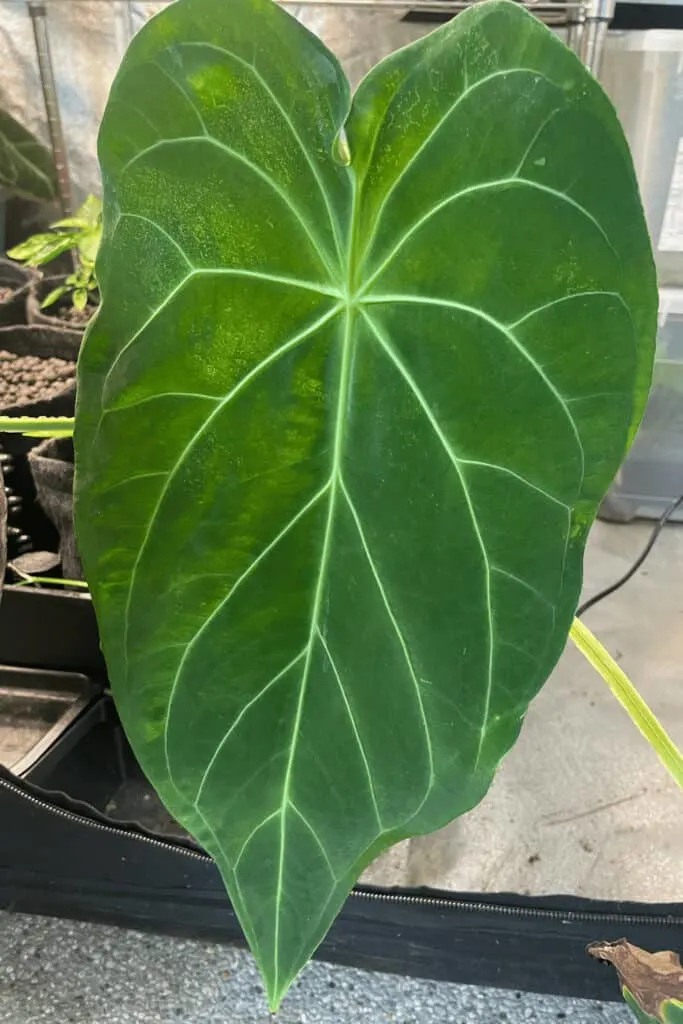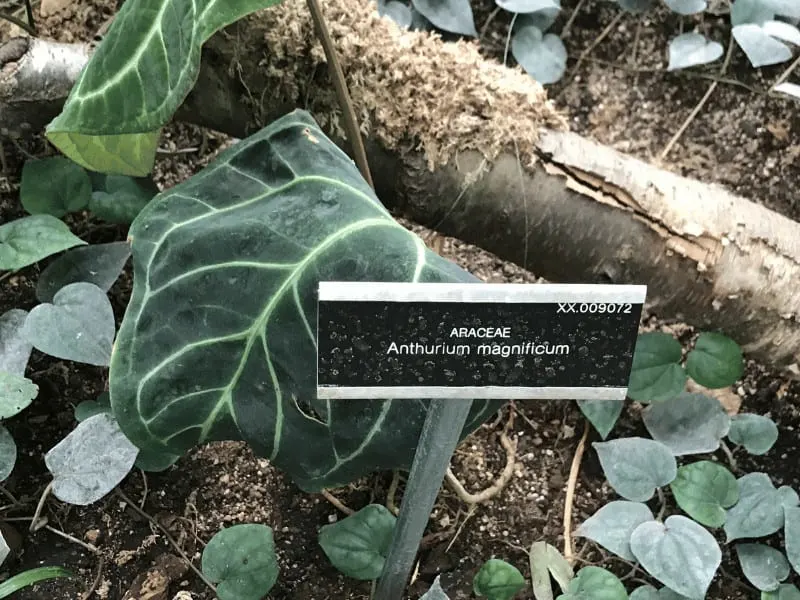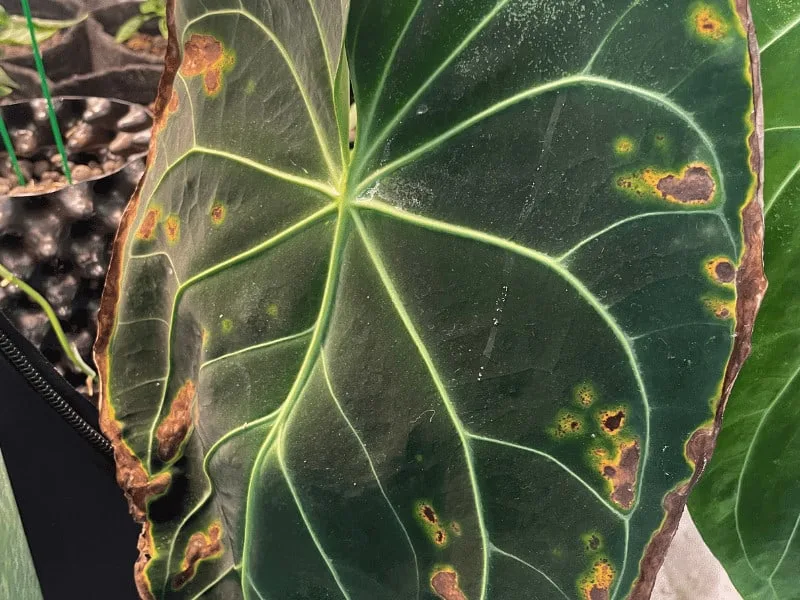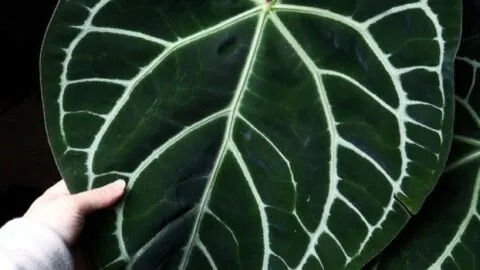You are here to get to know everything about Anthurium magnificum care as well as in-depth plant information.
Anthurium plants are wonderful creations of Mother Nature. And the Anthurium magnificum isn’t an exception.
They are related to Philodendrons and originate from warmer climates, particularly in South America.

Table of Contents
Anthurium Magnificum Plant
This Anthurium plant has large leather-like leaves. They’re a lush dark green with bright white contrasting veins. Some leaves even turn a coppery color that shines in the light.
The petioles on the plant are either four-sided, or they’re c-shaped.
I’ll walk you through the propagation steps and share the most common problems you might encounter.
Takeaways
| Species | Anthurium magnificum |
| Synonyms | Anthurium magnificum, Anthurium sanderi |
| Family | Araceae |
| Genus | Anthurium |
| Growth | Upright, Clumping |
| Height | 3.0 feet |
| Width | 2.0 feet |
| Soil | Well-draining soil mix |
| Watering | Water every 7-10 days |
| Light | Bright indirect |
| Temperature | Minimum: 70.0, Maximum: 85.0 |
| Humidity | Minimum: 60.0, Maximum: 80.0 |
| Fertilizer | 7.0 |
| Propagation | Stem cuttings or division |
| Toxicity | Toxic to cats, dogs, and humans. Contains water-insoluble calcium oxalate crystals. |
Anthurium Magnificum Plant Care
Soil
An Anthurium magnificum plant needs well-draining soil. Well-draining soil balances out the moisture in the soil so you don’t over-water or under-water.
First, well-draining soil ensures all that extra water doesn’t sit in the soil. Instead, it drains through to the bottom.
Your roots won’t be sitting in too much moisture, dying.
At the same time, the soil still retains the moisture it needs to grow and thrive. It’s the perfect balance of aeration in this type of soil.
Our favorite well-draining soil mix for the Anthurium magnificum includes:
- sphagnum peat moss
- perlite
- mulch
- charcoal
The sphagnum peat-moss creates aeration, so extra water goes on through.
And the perlite works to hold onto enough hydration for your plant’s health.
Light
For an Anthurium magnificum plant, bright indirect light is of utmost importance.
Since it originates from tropical climates, it thrives on the sun’s warmth and light.
But at the same time, these plants are partially sheltered by bigger plants and trees. This plant isn’t used to direct sunlight, so it damages the Anthurium’s leaves.
Avoid sitting it in a south or west-facing window. This will bring too much direct sunlight onto your plant. Instead, try an east or north-facing window.
If you use artificial lights, don’t place the plant right under these lights. Keep it a few inches away so it still gets enough light without getting harmed.
Since the Anthurium magnificum is dormant during winter, you don’t need as much light.

Watering
You have to keep an Anthurium magnificum plant well-hydrated. The soil should always be moist during their growing season, from March to September.
You don’t have to water it as often during the cold months. The cold air helps the soil hold onto moisture.
An under-watered plant leads to shriveling leaves and an unhealthy plant. And if it goes too long without enough hydration, it can and will die.
But you still have to be careful not to over-water your Anthurium. Over-watering is one of the deadliest things you can do to a plant.
The most common affliction caused by over-watering is root rot (or wet feet). When you saturate the soil, oxygen can’t reach the roots.
Oxygen is as important to your plant’s roots as water.
Without oxygen, the roots start to rot away. If it’s not treated right away, all the roots will rot. This kills your plant. The roots can’t absorb all the nutrients needed.
The best way to check if your Anthurium magnificum plant needs to be watered is by feeling the top layer of the soil.
You should be able to feel if the soil is moist. When it’s dry to the touch, you can water the plant.
Temperature
The temperature for your Anthurium magnificum should be between 65F (18C) and 75F (24C).
Avoid freezing temperatures and frost forming on the leaves. Do your best to never leave it in weather that’s 55F (13C) or lower.
This Anthurium plant can’t handle cold weather at all.
Humidity
You have to have high humidity for a thriving Anthurium magnificum. These plants crave the moisture in the air.
Unfortunately, most homes don’t have the humidity needed to keep your plant going. But you can remedy that situation.
If you live in an area with dry air, you will want to invest in a humidifier. It can create plenty of moisture in the air, and you can control it to what your plant likes.
Another popular method is the pebble tray method. It’s simple to create and you have almost everything you need at home.
You take a tray and fill it to the top with pebbles. The pebbles should be smooth and rounded so the plant pot can sit comfortably.
Once you fill the tray with pebbles, fill it with water. The water should sit right beneath the pebbles and not cover them.
Now you sit your Anthurium magnificum plant pot on the pebbles and wait. The water will evaporate, creating that much-needed moisture in the air.
Since your plant is sitting right on top of the water, the moisture will go straight for it.
You can also spritz the leaves of your plant on and off. The water will evaporate and your plant will absorb it.
The only downside to this method is that you don’t always know when to spray your Anthurium plant down. It’s a guessing game.
Fertilizer
Anthurium magnificum plants love fertilizer. This is one plant that you don’t want to skimp on fertilizer when caring for it.
You should fertilize your plant every six to eight weeks during the growing season.
You’ll fertilize the plant once during the colder months. The cold weather helps hold onto fertilizer for a longer time.
So be careful during winter because it’s common to over-fertilize. When you over-fertilize, the salt builds up in the soil. This burns the roots of your plant.
The only want to fix over-fertilized soil is by flushing or switching it out completely.

Propagation
There are two ways to propagate an Anthurium magnificum plant.
The first is the most common method used for most plants. That’s propagating through stem cuttings and soil. This is the easiest choice but not always the best choice for this plant.
The best process is through root division. It creates the strongest new Anthurium plants.
We’ll walk you through both propagating processes later on in this article.
Growth
The average Anthurium magnificum grows between two feet and five feet in height.
The leaves of this plant can get quite big. They range from six to 10 inches in length.
Potting
Re-potting an Anthurium magnificum is simple. The best time of year for this process is springtime.
This Anthurium plant takes about two years to outgrow a plant pot. You can also tell by the drainage holes in the pot. If the roots are sticking out, it’s time to change out.
The new plant pot should be only a bit bigger than the original. Anthurium roots get stressed out when they don’t feel compacted.
Anthurium Magnificum Propagation Steps
There are two methods of propagating an Anthurium magnificum. You should choose depending on what makes you comfortable.
The easiest method is through planting stem cuttings in soil. But the most promising method is through root division.
Using Stem Cuttings
According to the University of Maine, the process of stem cuttings involves using the existing plant to regenerate a new one.
The first thing you need is a high-quality Anthurium magnificum stem cutting. The stem cutting should be at least three inches in length and you should cut right beneath a leaf node. It’s a huge boost if there are still two leaves attached when you remove it. You need a sterilized pair of pruning shears to get your stem cutting. You can use isopropyl alcohol to sterilize and then you’re ready to make your cut.
It’s important to let your stem cutting cure. This means it needs to sit out in a warm environment for at least a week. This allows the cut end of the stem cutting to callous over.
While you’re waiting for your new stem cutting to cure, you can go ahead and get your plant pot ready. The plant pot should have drainage holes at the bottom. When the excess water drains through the soil, it’ll also drain through the bottom. Otherwise, the water is only going to sit there at the bottom of the soil.
Once a week is over, you can plant your stem cutting. Use your finger and stick in the soil a few inches deep. Place the stem cutting into this hole, making sure a few inches are sticking out. Pack the soil around the base to keep the stem cutting up.
If your stem cutting won’t stay up, tie it to a cut straw. You only need the straw until the stem cutting can sit up on its own.
Now you need to care for the stem cutting like the original Anthurium magnificum plant. Place the plant pot in an east or north-facing window. Make sure it’s getting adequate water to thrive.
Using Root Division
The first step of the root division process is to remove the original plant from its’ plant pot. You must be careful not to damage the roots while pulling the Anthurium magnificum plant out.
Run the faucet over the roots. You don’t want the water running at full blast because roots can be fragile. You want all the dirt off the roots, so dividing them will be much easier.
It’s time to remove some roots from the original Anthurium plant. Again, you want to be very careful so you don’t injure any roots.
Place the divided roots on a paper towel so they can dry out. Leave the roots out for about 24 hours. By this time, they should be plenty dry.
While the roots are drying, you can get the plant pot ready. The plant pot should have drainage holes at the bottom. Fill the new plant pot with your well-draining soil mix.
Once the roots aren’t wet, you can plant them to start your new Anthurium magnificum plant. Create a small hole in the soil for the roots. Ensure the roots are completely under the soil so they can grow and expand.
Now you have to care for the roots like you do the original plant. This means you must ensure it’s always hydrated and getting the right amount of indirect sunlight.
View this post on Instagram
Whenever it rains the first plant to get to go outside is always Augustus ? Anthurium magnificum x
Other Varieties of Anthuriums
There are over 1,000 different species of Anthurium plants. We have a hard time only picking a few.
But here are a few of our favorites to care for.
These are pretty cool Anthuriums. They grow super long and narrow leaves. They’re often referred to as “Queen Anthuriums.”
The Anthurium veitchii is another one of our favorite Anthurium plants. It’s nicknamed “King Anthurium”. Though they’re mostly grown outdoors due to their height, you can make due in most homes.
This Anthurium plant is on the smaller spectrum of Anthuriums. They create beautiful green leaves with thick white veins.
Anthurium obtusum
The Anthurium obtusum plant is one unique plant. The leaves are narrower than most. But the most interesting part of this plant is the flowers it produces. They resemble white pearls placed on top of each other.
Anthurium scandens
This Anthurium is a medium-sized plant. The leaves are very narrow and don’t to be very long. They also produce pretty flowers alongside the leaves.
Common Problems with the Anthurium Magnificum
Plant pests are a nuisance when caring for an Anthurium magnificum. There’s something about these plants that they love and find themselves attracted to.
It’s important to inspect any new plants you bring into your home before exposing them to your Anthurium. It’s the easiest way to prevent dealing with plant pests.
Regardless, you’ll still find yourself battling plant pests occasionally.
Aphids
Aphids are one of the most common plant pests found in Anthurium plants. They’re also among the smallest and hardest-to-see plant pests you’ll encounter.
They come in various colors, including brown, red, and white.
Aphids feed on the sap inside your plant. They have straw-like mouths that pierce through the flesh of the plant. Then the mouths proceed to suck the sap on through.
A small aphid infestation isn’t a big deal. The problem is that they breed fast. And once there’s a large infestation, your plant doesn’t have much chance.
A large infestation equals hundreds of mouths stealing the sap from the plant.
Plus, aphids leave waste behind when they feed. It’s a sugary honeydew substance that attracts ants. Ants are never good for plants.
Thrips
Thrips are also a common plant pest problem. These insects not only steal the sap from your plant but some species even bite humans.
You’ll have a hard time seeing these tiny creatures. But if you shake your plant, they’ll come out of hiding.
You don’t usually know you have a thrip infestation until your plant is sick. They come out of nowhere and leave your plant with zero nutrition.
Regarding these pests, it doesn’t matter if your infestation is small or large. It can do heavy damage in no time.
Spider mites
Spider mites are another possibility for a plant pest infestation. Unlike the other two on this list, they’re not actual insects. They’re arachnids with eight legs.
You can tell a spider mite infestation but tiny little webs forming around your plant’s leaves.
The best way to treat most plant pest infestations is by using all-natural neem oil. It’s less likely to harm your plant though you’ll still want to test an area to ensure no adverse reactions.
Always dilute the neem oil with water. Mix them in a clean spray bottle. Then you can spray the plants down with the oil.
Neem oil is a thick substance that suffocates the pests almost immediately. Within a few minutes, all you’ll have to do is wipe the dead pests off your plant.
Tips for an Unhappy Anthurium Magnificum
No matter what plant you care for, you’re going to come across issues from time to time.
With some patience and love, you can keep your Anthurium magnificum plant happy.
These are a couple of the most common issues you may encounter and how to solve them.
Your Anthurium Magnificum Plant’s Leaves are Yellowing
Yellowing leaves on an Anthurium magnificum is the first sign of over-watering. Your plant standing in water is one of the worst things you can do to it.
You’ll want to pull the plant out from the pot to ensure the roots are fine. If there’s root rot, you have a lot of work to do. If all the roots are rotten, your plant doesn’t survive.
When the roots are fine, the only real step is to water your plant less. Unless the soil is too saturated, you’ll want to switch it out into fresh and dry soil.
Your Anthurium Magnificum Plant’s Leaves are Dying in Spots
Anthurium magnificum plants that are decaying are getting too much direct light.
These decaying spots are scorch marks from the light blaring down on the leaves.
It’s in the plant’s best interest to go ahead and trim the burned leaves. These leaves aren’t going to get better the way they are.
On the bright side, your plant isn’t going to die. You only need to remove it from direct sunlight. Wherever your plant is placed, move it to an area with less light (as we have seen earlier on, bright, indirect sunlight is the way to go).
Anthurium Magnificum FAQ
Is my Anthurium magnificum toxic to my pets?
Yes, the Anthurium magnificum plant is toxic to both pets and humans. Like Philodendron plants, Anthuriums are covered in large amounts of calcium oxalate crystals. This irritates the throat and esophagus going down.
Should I dilute the fertilizer I use for my Anthurium magnificum?
Yes, you should dilute the fertilizer you use for your Anthurium magnificum plant. It’s easy for salt to build up in the soil and burn the plant’s roots.
When should I first re-pot my Anthurium magnificum?
You should re-pot your Anthurium magnificum plant as soon as you get home with it. Most places won’t have the correct soil for the Anthurium.
Conclusion
The Anthurium magnificum is one of our favorite Anthurium plants to grow inside. It stands out from the other species and fits in well with Philodendron plants.


